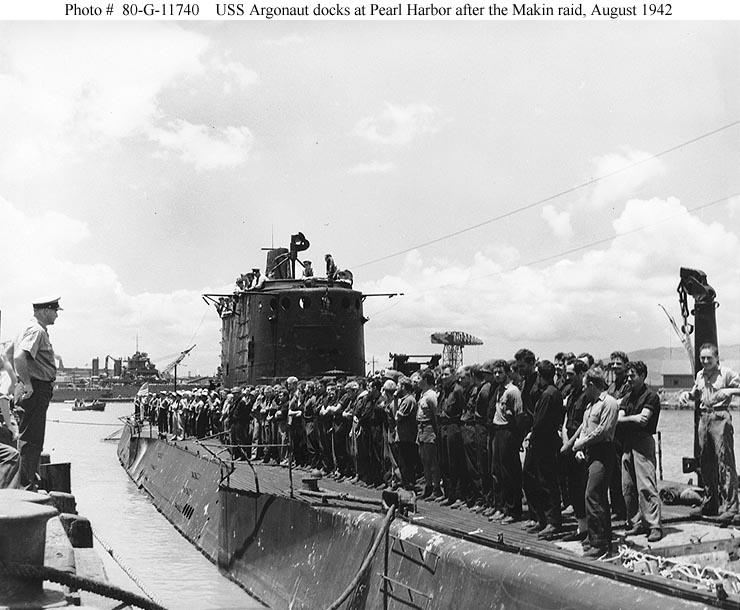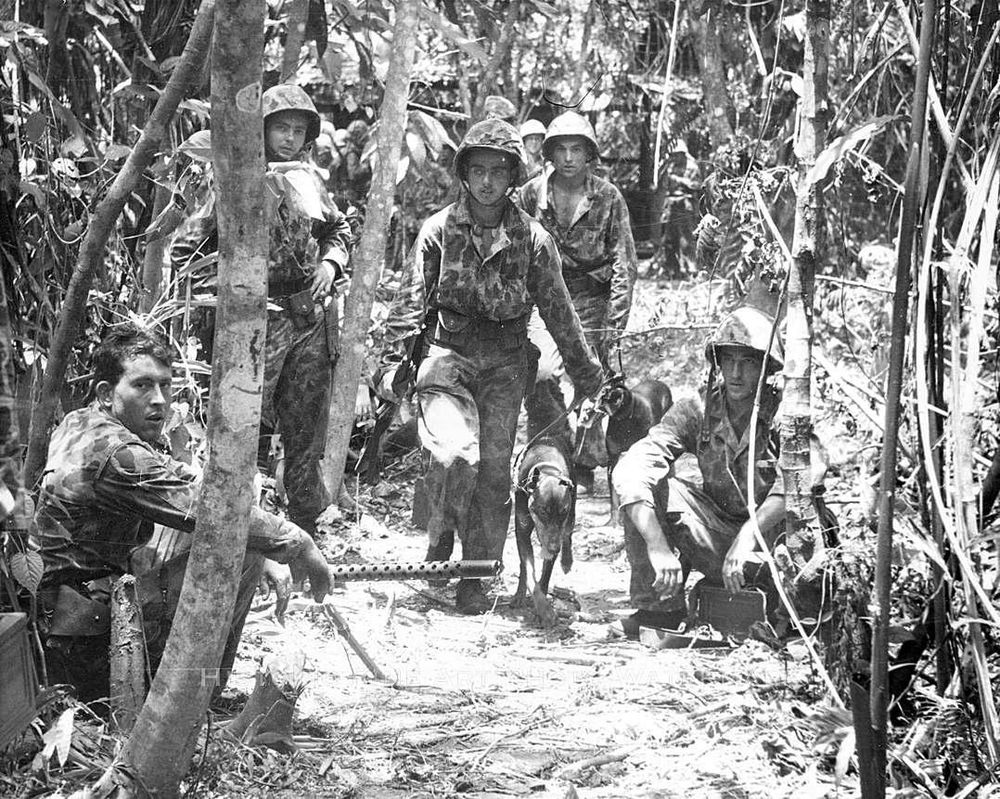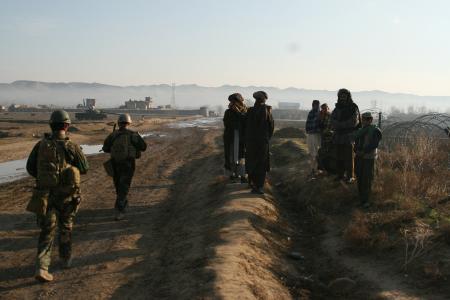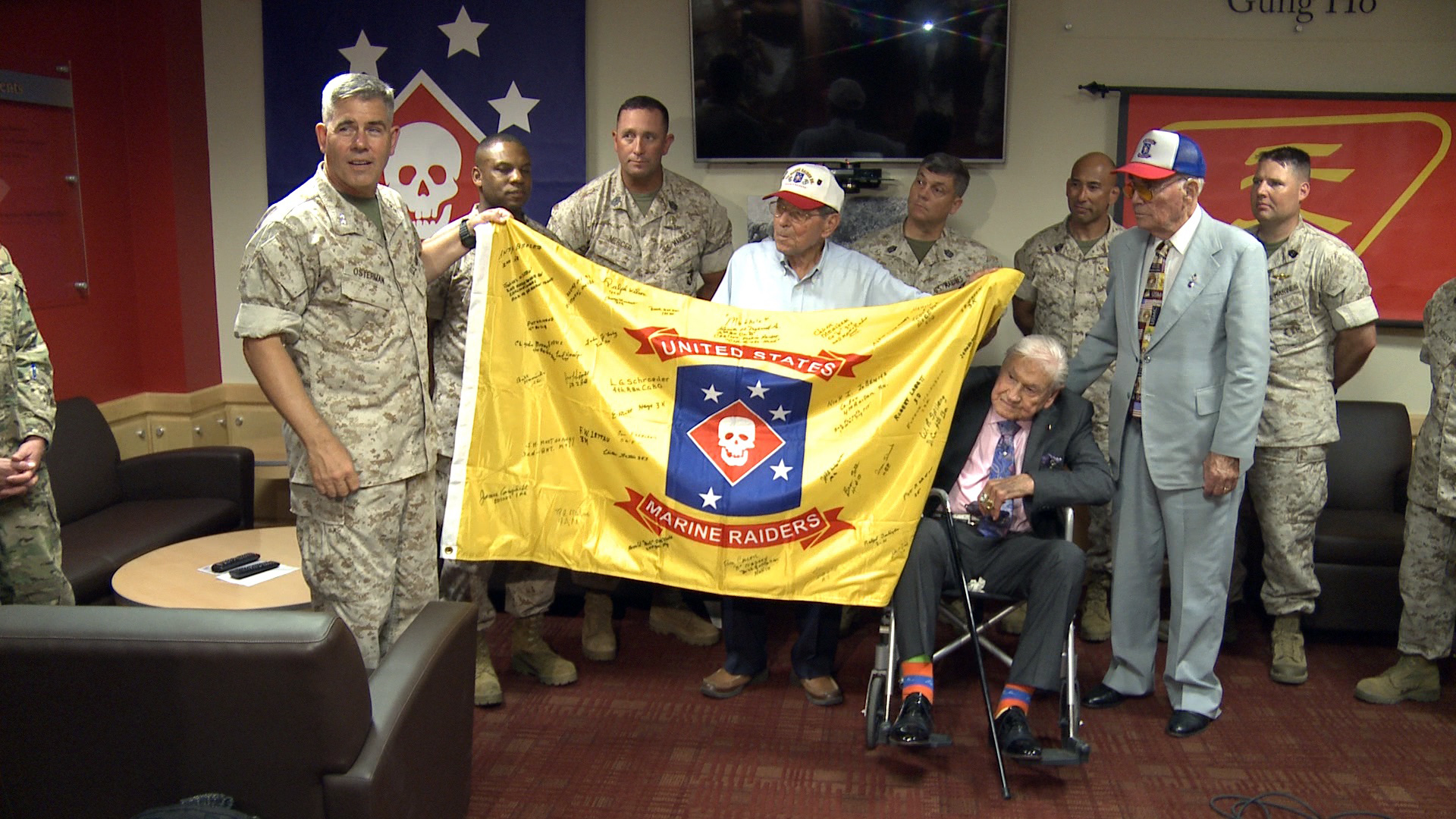February 1942
February, 1942
In February, 1942, the 1st and 2nd Separate Battalions were designated 1st and 2nd Marine Raider Battalions
June 1942
June, 1942
In June, 1942, 2nd Raider Battalion participated in the sea and air battles of Midway Island, with two companies stationed on North Island and Sand Island during the battles. After nearly two weeks, the companies boarded U.S. warships and returned to Pearl Harbor.
August 1942
August 7th, 1942
On August 7th, 1942, 1st Raider Battalion conducted an amphibious assault landing on the island of Tulagi in the British Solomon Islands.
August 9th, 1942
On August 9th, 1942, two companies from 2nd Raider Battalion embarked at Pearl Harbor aboard two submarines, the SS Argonaut (SS-166) and the SS Nautilus (SS-168), and sailed for the Gilbert Islands. A week later, 2nd Raider Battalion conducted the famed assault landing on Butaritari Island, Makin Atoll, launching rubber raiding boats from the decks of the submarines.
September 1942
September 8th, 1942
On September 8th, 1942, 1st Raider Battalion conducted a daring raid on the Japanese supply base at Tasimboko, Guadalcanal, beginning a month long fight in the legendary Battle of Guadalcanal. Four days later, on September 12th, they began the Battle of Edson’s Ridge (also known as “Bloody Ridge”) in the successful defense of Henderson Airfield. After another month of fighting, 1st Battalion was withdrawn from the island.
September 20th, 1942
On September 20th, 1942, 3rd Raider Battalion was formed in American and Western Samoa, as well as the Wallis Island Group from elements of the 7th Marine Regiment.
October 1942
October 23rd, 1942
On October 23rd, 1942, 4th Marine Raider Battalion was organized at Camp Joseph H. Pendleton, Oceanside, CA.
November 1942
November 4th, 1942
On November 4th, 1942, 2nd Raider Battalion conducted an amphibious assault at Aola Bay, Guadalcanal, and begins a 30-day guerrilla mission known as “The Long Patrol.” Over the next thirty days, the battalion participated in six major battles. On December 4th, the battalion returned to friendly lines at Henderson Field. 2nd Raider Battalion left Guadalcanal on December 15th, 1942.
March 1943
March 15th, 1943
On March 15th, 1943, 1st Marine Raider Regiment was established on Espiritu Santo Island, New Hebrides Islands. The Regiment consisted of Headquarters, 1st, 2nd, 3rd, and 4th Raider Battalions.
June 1943
June 21st, 1943
On June 21st, 1943, elements of 1st and 4th Raider Battalions participated in the occupation of Segi Point, New Georgia, in the British Solomon Islands. For the next week, the battalions fought in several key battles of the New Georgia campaign, to include Choi River, Viru Village, and Tombe Harbor. In early July, the Raiders consolidated on the island and participated in the Battle of Keruka, Wickham Anchorage. The fighting on New Georgia continued for another two months, with the battalions leaving for good in late August. Both units eventually made their way to New Zealand for Rest and Rehabilitation.
November 1943
November 1st, 1943
On November 1st, 1943, elements of the 2nd and 3rd Raider Battalions assaulted the Japanese fortifications at Cape Torokina, Empress Augusta Bay, Bougainville. Both units continued fighting through the end of November, participating in the battles of Piva Trail, Coconut Grove, and Numa Numa Trail over a 10-day period. On January 12th, both Raider Battalions were withdrawn from Bougainville and sent to New Zealand for Rest and Rehabilitation.
February 1944
February 1st, 1944
On February 1st, 1944, the Marine Corps identified a need to consolidate the Raider Regiments in order to most effectively combat front-line Japanese troops. Ultimately, the legacy of the Raider Battalions would live on in the Marine Corps with the adoption of Lt. Col. Evans Carlson’s Fire Team model, and Lt. Col. Merritt Edson’s structure of a battalion having 3 to 4 rifle companies and a weapons company, with each company hosting 3 rifle platoons and a weapons platoon. The legacy of the Raiders’ small boat tactics would live on as the 1st, 3rd, and 4th Raider Battalions became 1st, 2nd, and 3rd Battalions of the 4th Marine Regiment. 2nd Raider Battalion was disbanded and its Raiders were spread amongst the other units.
June 2003
June 2003
On June 19, 2003, Marine Corps Special Operations Command Detachment One, also known as “Det One”, was created as a pilot program to assess the value of Marine special operations forces permanently detached to the United States Special Operations Command. It was commanded by Col. Robert J. Coates, former Commanding Officer of 1st Force Reconnaissance Company and it was headquartered at Camp Del Mar Boat Basin. Det One was disbanded in 2006 and succeeded by the permanent United States Marine Corps Forces Special Operations Command (MARSOC).
November 2005
November 23rd, 2005
On November 23rd, 2005, Secretary of Defense Donald Rumsfeld announced the approval for the creation of the Marine Corps Forces, Special Operations Command (MARSOC), and on February 24th, 2006, MARSOC was officially established. Under the leadership of Brigadier General Dennis J. Hejlik, MARSOC was built from the 4th Marine Expeditionary Brigade (4th MEB), the Foreign Military Training Unit (FMTU), and 1st and 2nd Force Reconnaissance Companies. FMTU became the Marine Special Operations Advisor Group (MSOAG), with missions in Africa and South America. 1st and 2nd Force Reconnaissance Companies became 1st and 2nd Marine Special Operations Battalions (MSOB) and were tasked with providing support to Operation Enduring Freedom - Afghanistan. In January, 2007, the Marine Special Operations Support Group was activated with MARSOC personnel deployed in Marine Special Operations Team (MSOT) and Marine Special Operations Company (MSOC) formations in South America, Africa, and Afghanistan.
October 2008
October, 2008
MARSOC continued its growth under the leadership of Major General Maston Robeson in 2008, formalizing a pipeline for the screening, assessment, selection, and training of MARSOC Marines and activating the Marine Special Operations School (MSOS). The first formal Individual Training Course (ITC) commenced in October of 2008, and has continued to produce certified Critical Skills Operators and Special Operations Officers as often as three times a year.
May 2009
May, 2009
In 2009, MARSOC expanded its footprint in Afghanistan, sending two full MSOCs and a Special Operations Task Force by year’s end. In May of 2009, MSOAG was reflagged as the 3d Marine Special Operations Battalion and continued supporting special operations missions across the world. In August of 2009, the Marine Special Operations Regiment (MSOR) was activated. In November, 2009, Major General Paul Lefebvre assumed command of MARSOC as it reached its peak numbers of deployed forces, with almost 600 MARSOC Marines and Sailors serving overseas, while the whole of MARSOC was just under 2000 men and women at the time. MARSOC would continue this operational tempo through 2011.
January 2011
January 24, 2011
On 24 January, 2011, the Marine Corps approved a Primary Military Operational Specialty for enlisted MARSOC Marines who successfully completed ITC. Known as Critical Skills Operators, or CSO’s, MARSOC Marines would be able to continue serving at MARSOC throughout their career. That same announcement also created the Special Operations Capabilities Specialists (SOCS), the subject matter experts who provide unique support to MARSOC units. This announcement by the Marine Corps was critical in ensuring the continued growth and success of the Marine Special Operations Command.
August 2012
August, 2012
In August, 2012, Major General Mark Clark assumed the role of Commanding General as MARSOC began to withdraw its forces from the war in Afghanistan. In 2013, MARSOC and the U.S. Special Operations Command worked hand-in-hand with the Marine Corps to develop a relationship between Marine Corps’ Marine Expeditionary Units (MEU) and Special Operations Forces. In 2014, MARSOC provided the first-ever Special Operations Forces Liaison Element to the 11th MEU, and 1st MSOB sent the first MARSOC forces to Guam.
April 2014
April, 2014
In April of 2014, the Marine Corps continued its support to the growth of the MARSOC force by approving a Military Occupational Specialty of Special Operations Officer for all future MARSOC officers who were graduates of the Individual Training Course.
August 2014
August 6, 2014
On August 6th, 2014, Major General Joseph Osterman assumed command of MARSOC, and on that same day, Commandant of the Marine Corps, General James Amos, officially granted MARSOC the title of “Marine Raiders.” This decision honors the legacy of America’s first special operations forces, the Marine Raiders of World War Two, and carries their name on with today’s Marine Raiders.
October 2014
October, 2014
In October of 2014, MARSOC redeployed its final units from Afghanistan, completing its support to Operation Enduring Freedom and ending MARSOC’s first significant chapter of combat operations.
January 2015
January, 2015
In January, 2015, MARSOC completed its shift to regionalized operations when 2nd MSOB sent a company to support missions in the U.S. Central Command theater of operations, beginning support to Operation Inherent Resolve in response to the advances made by ISIS. This deployment officially aligned the three Marine Special Operations Battalions: 1st MSOB aligned to U.S. Pacific Command, 2nd MSOB aligned to U.S. Central Command, and 3d MSOB aligned to U.S. Africa Command.
June 2015
June 19th, 2015
On June 19th, 2015, the Marine Special Operations Regiment, Marine Special Operations Support Group and their organic battalions were formally recognized, re-designated, and reflagged as the Marine Raider Regiment, Marine Raider Support Group, Marine Raider Support Battalions, and Marine Raider Battalions.






















